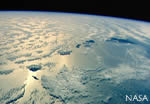
 Plants
and animals moved from their native habitats to new locations by humans,
either accidentally or intentionally, are considered to be alien or introduced
species. When in a new environment, introduced species can compete with
native ones for food or space; introduce new pests, parasites, or pathogens;
and generally cause a disruption in the native environment.
Plants
and animals moved from their native habitats to new locations by humans,
either accidentally or intentionally, are considered to be alien or introduced
species. When in a new environment, introduced species can compete with
native ones for food or space; introduce new pests, parasites, or pathogens;
and generally cause a disruption in the native environment.
 The
Hawaiian Islands form the most isolated archipelago in the world, with
North America being its closest neighbor. Such island ecosystems are often
highly susceptible to invasion by exotic species. On land in the Hawaiian
Islands there are more than 4000 introduced species. Recent studies have
shown that there are also more than 300 species of plants and animals
introduced into coastal marine and estuarine waters.
The
Hawaiian Islands form the most isolated archipelago in the world, with
North America being its closest neighbor. Such island ecosystems are often
highly susceptible to invasion by exotic species. On land in the Hawaiian
Islands there are more than 4000 introduced species. Recent studies have
shown that there are also more than 300 species of plants and animals
introduced into coastal marine and estuarine waters.
Through the Hawaii Biological Survey at Bishop Museum, a count of the total number of species in the Archipelago has been compiled. In 1999, the time of the last tally, there were 23,150 known species of terrestrial and aquatic algae, plants and animals, including 5047 nonindigenous species (~ 20%). The total number of marine and brackish water alien species in the Hawaiian Islands is 343, including 287 invertebrates, 24 algae, 20 fish, and 12 flowering plants.
 This
brief guide was assembled to provide information concerning some of the
most common marine alien species to people who spend time in the coastal
waters of Hawaii. Some of the more recent discoveries of alien species
have been made by photographers and aquarium collectors. It is hoped that
when individuals observe animals not previously seen, they will bring
them to the attention of the appropriate people. This guidebook is by
no means comprehensive. An additional 250+ species of algae and animals
are not yet included.
This
brief guide was assembled to provide information concerning some of the
most common marine alien species to people who spend time in the coastal
waters of Hawaii. Some of the more recent discoveries of alien species
have been made by photographers and aquarium collectors. It is hoped that
when individuals observe animals not previously seen, they will bring
them to the attention of the appropriate people. This guidebook is by
no means comprehensive. An additional 250+ species of algae and animals
are not yet included.
The Workshop was sponsored by the Packard Foundation and the U.S. Fish
and Wildlife Service, together with the Bishop Museum and University of
Hawaii. Additonal support for production of the guidebook was provided
by the National Marine Fisheries Service.
© 2002 Hawaii Biological Survey, Bishop Museum
contact